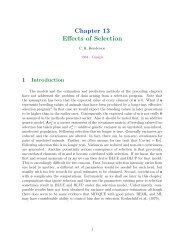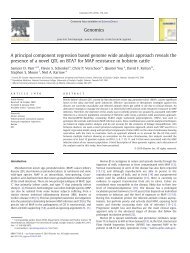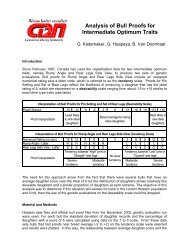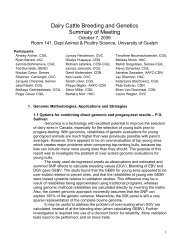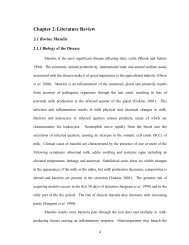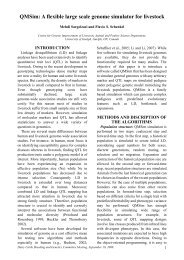Test-day fat to protein ratio as an indicator trait for sub-clinical ...
Test-day fat to protein ratio as an indicator trait for sub-clinical ...
Test-day fat to protein ratio as an indicator trait for sub-clinical ...
You also want an ePaper? Increase the reach of your titles
YUMPU automatically turns print PDFs into web optimized ePapers that Google loves.
White cattle. Estimates of Meinert et al. (1989) <strong>for</strong> this <strong>trait</strong> were 0.31 <strong>for</strong> the part of<br />
lactation from 40 <strong>to</strong> 100 DIM <strong>an</strong>d 0.69 <strong>for</strong> the entire 305 d lactation <strong>for</strong> the same<br />
population. Lower heritability of F:P (0.14) w<strong>as</strong> estimated <strong>for</strong> Austri<strong>an</strong> Simmentals<br />
(Gredler et al. 2006) <strong>an</strong>d <strong>for</strong> Sp<strong>an</strong>ish Holsteins (0.19) (Peña, 2006). Genetic correlations<br />
between milk yield <strong>an</strong>d <strong>protein</strong> <strong>to</strong> <strong>fat</strong> <strong>ratio</strong> w<strong>as</strong> 0.19 <strong>for</strong> the entire 305 d lactation <strong>an</strong>d -<br />
0.15 <strong>for</strong> DIM from 40 <strong>to</strong> 100 (Meinert et al. 1989), <strong>an</strong>d 0.18 (Vos <strong>an</strong>d Groen, 1998).<br />
Estimates of phenotypic correlation between these <strong>trait</strong>s r<strong>an</strong>ged from 0.19 (Vos <strong>an</strong>d<br />
Groen, 1998) <strong>to</strong> 0.88 (Meinert et al. 1989). To our knowledge, estimates of correlation<br />
between F:P <strong>an</strong>d SCS have not been up till now a <strong>sub</strong>ject of <strong>an</strong>y published study.<br />
Producer-recorded data collection of <strong>clinical</strong> m<strong>as</strong>titis c<strong>as</strong>es started in 2007 in<br />
C<strong>an</strong>adi<strong>an</strong> dairy herds, with the objective <strong>to</strong> develop genetic selection <strong>to</strong>ols <strong>for</strong> resist<strong>an</strong>ce<br />
<strong>to</strong> <strong>clinical</strong> m<strong>as</strong>titis. Selection index b<strong>as</strong>ed on genetic evaluations of SCS <strong>an</strong>d mammary<br />
system con<strong>for</strong>mation will likely continue <strong>to</strong> complement direct selection against <strong>clinical</strong><br />
m<strong>as</strong>titis. <strong>Test</strong>-<strong>day</strong> milk yield <strong>an</strong>d F:P, especially at the beginning of lactation, seem <strong>to</strong> be<br />
potential <strong>trait</strong>s that could contribute <strong>to</strong> the accuracy of such <strong>an</strong> index, with the overall<br />
goal of reducing m<strong>as</strong>titis incidence in C<strong>an</strong>adi<strong>an</strong> dairy cattle.<br />
CONCLUSIONS<br />
A mixture model <strong>for</strong> TD milk, F:P <strong>an</strong>d SCS allowed cl<strong>as</strong>sification of the data in<strong>to</strong><br />
two components: healthy <strong>an</strong>d infected with putative, <strong>sub</strong>-<strong>clinical</strong> m<strong>as</strong>titis. Distributions<br />
of data differed in me<strong>an</strong>s <strong>an</strong>d vari<strong>an</strong>ces between mixture components <strong>an</strong>d across different<br />
parts of lactation. Frequency of m<strong>as</strong>titic records w<strong>as</strong> high immediately after calving <strong>an</strong>d<br />
decre<strong>as</strong>ed <strong>as</strong> lactation progressed. Records from infected cows had lower TD milk yield,<br />
<strong>an</strong>d higher F:P <strong>an</strong>d SCS, <strong>as</strong> compared with healthy cows. Fat <strong>to</strong> <strong>protein</strong> <strong>ratio</strong>, e<strong>as</strong>ily<br />
available, highly heritable <strong>an</strong>d relatively independent from milk <strong>an</strong>d SCS, could serve <strong>as</strong><br />
<strong>an</strong> additional indica<strong>to</strong>r <strong>for</strong> indirect selection against m<strong>as</strong>titis in dairy cattle.<br />
REFERENCES<br />
Boettcher P.J., Caraviello D., Gi<strong>an</strong>ola D. (2007) J. Dairy Sci., 90, 435-443.<br />
Boettcher P.J., Moroni P., Pisoni G., Gi<strong>an</strong>ola D. (2005) J. Dairy Sci., 88, 2209-2216.<br />
Buttchereit N., Stamer E., Junge W., Thaller G. (2009J. Dairy Sci., 93, 1702-1712.<br />
Carlén E., Str<strong>an</strong>dberg E., Roth A. (2004) J. Dairy Sci., 87, 3062-3070.<br />
de Ha<strong>as</strong> Y., Veerkamp, R.F., Barkema H.W., Gröhn Y.T., Schunken Y.H (2004) J. Dairy<br />
Sci., 87, 95-105.<br />
Detilleux J., Leroy P.L. (2000) J. Dairy Sci., 83, 2341-2349.<br />
Gi<strong>an</strong>ola D., Heringstad B., Ødegård J. (2006) Genetics, 173, 2247-2255.<br />
Gredler B., Fuerst C., Sökner J. (2006) Proc. 6 th World Congress on Genetics Applied <strong>to</strong><br />
Lives<strong>to</strong>ck Production, August 13-18, 2006, Bello Horizonte, Br<strong>as</strong>il, Communication No.<br />
11-05.<br />
Gürtler H., Schweiger F.J. (2005) Physologie der Laktation. Pages 552-573 Physologie<br />
der Haustiere. Vol. 2. W. von Engelhard <strong>an</strong>d C. Breves, ed. Enke Verlag, Stuttgart,<br />
Germ<strong>an</strong>y.<br />
Heringstad B., Ch<strong>an</strong>g Y.M., Gi<strong>an</strong>ola D., Klemetsdal G. (2003) J. Dairy Sci., 86, 2676-<br />
2683.<br />
Heuer C., Schunken Y.H., Dobbelaar P. (1999) J. Dairy Sci., 82, 295-304.<br />
Jamrozik J., Gi<strong>an</strong>ola D., Schaeffer L.R. (2001) Livest. Prod. Sci., 71(2-3), 223-240.<br />
6





